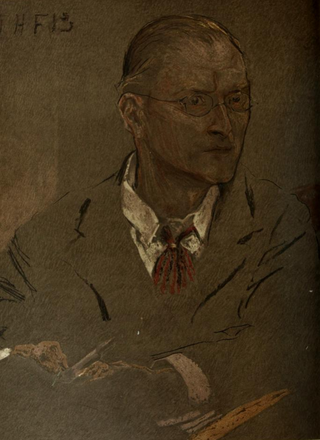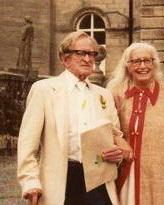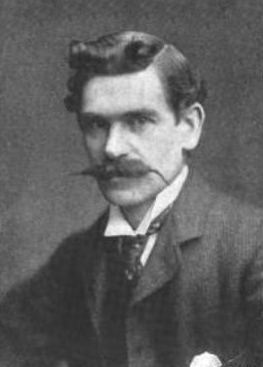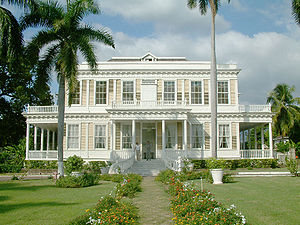
Art Nouveau is an international style of art, architecture, and applied art, especially the decorative arts. It was often inspired by natural forms such as the sinuous curves of plants and flowers. Other characteristics of Art Nouveau were a sense of dynamism and movement, often given by asymmetry or whiplash lines, and the use of modern materials, particularly iron, glass, ceramics and later concrete, to create unusual forms and larger open spaces. It was popular between 1890 and 1910 during the Belle Époque period, and was a reaction against the academicism, eclecticism and historicism of 19th century architecture and decorative art.

Thomas Chippendale (1718–1779) was a cabinet-maker in London, designing furniture in the mid-Georgian, English Rococo, and Neoclassical styles. In 1754 he published a book of his designs in a trade catalogue titled The Gentleman and Cabinet Maker's Director—the most important collection of furniture designs published in England to that point which created a mass market for furniture—upon which success he became renowned. According to the Victoria and Albert Museum, "so influential were his designs, in Britain and throughout Europe and America, that 'Chippendale' became a shorthand description for any furniture similar to his Director designs".

Spanish Town is the capital and the largest town in the parish of St. Catherine in the historic county of Middlesex, Jamaica. It was the Spanish and British capital of Jamaica from 1534 until 1872. The town is home to numerous memorials, the national archives, and one of the oldest Anglican churches outside England.

The Italianate style was a distinct 19th-century phase in the history of Classical architecture. Like Palladianism and Neoclassicism, the Italianate style drew its inspiration from the models and architectural vocabulary of 16th-century Italian Renaissance architecture, synthesising these with picturesque aesthetics. The style of architecture that was thus created, though also characterised as "Neo-Renaissance", was essentially of its own time. "The backward look transforms its object," Siegfried Giedion wrote of historicist architectural styles; "every spectator at every period—at every moment, indeed—inevitably transforms the past according to his own nature."

Charles Francis Annesley Voysey was an English architect and furniture and textile designer. Voysey's early work was as a designer of wallpapers, fabrics and furnishings in a Arts and Crafts style and he made important contribution to the Modern Style, and was recognized by the seminal The Studio magazine. He is renowned as the architect of several country houses.

Chennai architecture is a confluence of many architectural styles. From ancient Tamil temples built by the Pallavas, to the Indo-Saracenic style of the colonial era, to 20th-century steel and chrome of skyscrapers. Chennai has a colonial core in the port area, surrounded by progressively newer areas as one travels away from the port, punctuated with old temples, churches and mosques.

The architecture of Canada is, with the exception of that of Canadian First Nations, closely linked to the techniques and styles developed in Canada, Europe and the United States. However, design has long needed to be adapted to Canada's climate and geography, and at times has also reflected the uniqueness of Canadian culture.

Edwin Maxwell Fry, CBE, RA, FRIBA, FRTPI, known as Maxwell Fry, was an English modernist architect, writer and painter.
Australian non-residential architectural styles are a set of Australian architectural styles that apply to buildings used for purposes other than residence and have been around only since the first colonial government buildings of early European settlement of Australia in 1788.

James Miller (1860–1947) was a Scottish architect, recognised for his commercial architecture in Glasgow and for his Scottish railway stations. Notable among these are the American-influenced Union Bank building at 110–20 St Vincent Street; his 1901–1905 extensions to Glasgow Central railway station; and Wemyss Bay railway station on the Firth of Clyde. His lengthy career resulted in a wide range of building types, and, with the assistance of skilled draughtsmen such as Richard M Gunn, he adapted his designs to changing tastes and new architectural materials and technologies.

The Railways of Jamaica, constructed from 1845, were the second British Colony after Canada's Champlain and St Lawrence Railroad of 1836 to receive a railway system. Construction started only twenty years after the Stockton & Darlington Railway commenced operations in the United Kingdom.

The following outline is provided as an overview of and topical guide to Jamaica:

Hibbert House, also known as Headquarters House, is the head office of the Jamaica National Heritage Trust. It is located at 79 Duke Street in Kingston, Jamaica. It was built by Thomas Hibbert, a wealthy young English merchant, in 1755 to serve as his residence. Hibbert migrated to Kingston in 1734, at a time when Jamaica was becoming the largest and wealthiest of the British Caribbean islands and the largest single destination of African slaves. In the early 1750s, he formed a partnership with Nathaniel Sprigg to serve as factors for slaves, purchasing them off the ships from Africa and reselling them to planters and others in Jamaica. Hibbert also helped found a major West Indian house in London, trading in sugar and rum.

Kingston railway terminus was built in the Jamaica Georgian architectural style using brick. It was constructed on a grand scale, symbolising its importance as the main terminus of the Jamaica railways. It has prominent arcades on both levels of the east entrance end. Victorian cast iron brackets support the roof overhang on the trackside. It has sash windows on the ground and upper floors.
Anchovy railway station opened in c1894 and closed in 1992. It served the small town of Anchovy, Jamaica on the Kingston to Montego Bay line and was 105.75 miles (170.19 km) from the Kingston terminus.

Spanish Town railway station opened in 1845 and closed in 1992 when all passenger services in Jamaica abruptly ceased. It provided rail services to Kingston and Montego Bay, Port Antonio, Ewarton and New Works. It was 11.75 miles (18.91 km) from the Kingston terminus. It is on the list of designated National Heritage Sites in Jamaica.
Montpelier railway station opened in 1895 and closed in 1992. It served the village of Montpelier on the Kingston to Montego Bay line and was 103 miles (166 km) from the Kingston terminus. It is on the list of designated National Heritage Sites in Jamaica.
Balaclava railway station opened in 1892 and closed in 1992. It served the small town of Balaclava on the Kingston to Montego Bay line and was 70.5 miles (113.5 km) from the Kingston terminus.

John A. Wood, was an American architect. His work in upstate New York included projects in Poughkeepsie and Kingston, New York as well as four armories, in Kingston, Newburgh, Bethel, and Watertown. His work in Tampa, Florida includes the Tampa Bay Hotel and Old Hillsborough County Courthouse. His hotel work included the design of the Piney Woods Hotel, Oglethorpe Hotel, Mizzen Top Hotel, and Grand Hotel.














